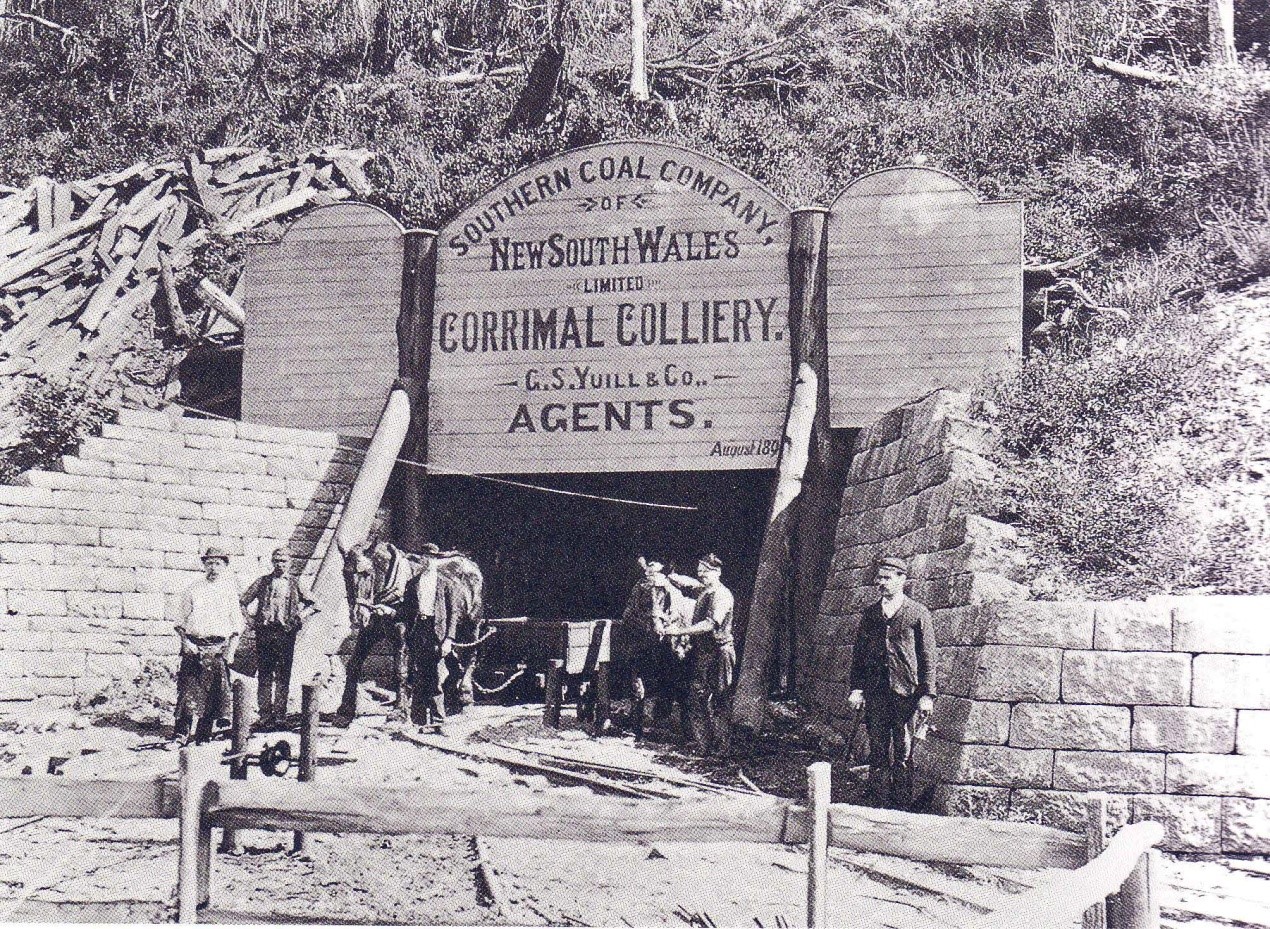
HIGHLIGHTS
1870 – 1986
- Opened – 1870 – Exploratory adit under Broker’s Nose
- Re-opened - 1885 – Broker’s Nose Colliery
- Manager – T. Bertram
- Name change – 1889 Corrimal Colliery
- Name change – 1906 Corrimal-Balgownie Colliery
- Closed – 1985
- Sealed - 1991
DETAILS
1870 – Circa – commenced operations?
1870 – Advert by Order of Mortgagee – Sale of Balgownie Estate, Wollongong. 1047 acres, 2 roods & 16 perches includes Lots 15 & 16; 24, 25 & 26; 41 to 44; 45, 46 & 47; 48, 51: 49 & 50. Includes 500 to 550 acres of coal lands with 7 foot seam and Mt Pleasant Mine on the boundary. A trial mine has been opened and coal found to be equal to that produced elsewhere in the district? (SMH 10/09/1870 p11)
1873 – A Mr Thomas instructs that his farm (known as Griffin’s Farm) at Mt Corrimal (Broker’s Nose) be sold by auction. (Ill Mer. 25/03/1873 p3)
1883 – Aug 1st – “A large English company, which has leased land at Mt Corrimal from Capt. Osborne, is to commence iron works and coal mining as soon as the railway is extended so far into the Illawarra”. (SMH 1/8/1883)
1884 – Capt. Osborne (Mt. Keira Colliery) instrumental in obtaining 500 acres of coal bearing property from Major Owen and D. Griffin at Mt. Corrimal (Brooker’s Nose/Broker’s Nose) and leasing it to the Brooker’s Nose Coal Company.
1885 – May 22nd – Mr T. Bertram, General Manager, gives notice to DoM that they had commenced operations to open a new mine to be known as Broker’s Nose Colliery. “Arrangements are underway to connect the mine to the Illawarra line. An airshaft, some 100 ft. (30.5m) deep, has already been sunk and a tunnel some 176 yds. (161m) westerly into the seam. 4 men are employed underground with an air supply of 4000 cfm.” (DoMAR 1885)
1885 – May 23rd – the first entry made in an order book headed “The Brooker’s Nose Colliery Co. Ltd.” confirming the correct name for the colliery. The book was located in the old workings of the mine by Mr. Gordon Worland, the mines chief surveyor, around 1945. The final entry was April 9th. 1901. The early orders were signed by Mr Bertram. (Ill Merc. 2/11/1945, p14)
1885 – The Brooker’s Nose Coal Mining Co is pushing on the work of opening out their colliery about midway between Wollongong and Bulli. Here a heading has been driven and an incline and portion of a railway to connect with the Illawarra line has been constructed. A number of men are under Mr. T. Bertram, C.E. who has charge of the colliery. (Aust. Town & Country Journal, 4/7/1885)
1885, Sep 3rd – “On May 22nd T. Bertram gave notice that he had commenced operations to open out a new mine to be known as the Broker’s Nose Colliery, near Wollongong. (SMH 3/9/1885)
1885 – Nov 28th – Mr. Brissenden, managing director of Brooker’s Nose Colliery Company, with Mr. Bertram, the colliery manager is selecting a site for a coke works. The company has opened out a colliery on its property on Mt. Corrimal but cannot ship coal due to the non-completion of the Illawarra Railway. (Aust. Town & Country Journal. 28/11/1885)
1885 – Brooker’s Nose Company – “Conscious decision not to call the company Mount Corrimal (Brooker’s Nose) as already several “Mount” collieries in the area. Lands secured from Major Owen and Mr D. Griffin and consists of approximately 500 acres. A tunnel some 1,000 ft. (305m) has been driven in the Bulli seam in coal averaging 7 ft. (2.1m) thick. An upcast shaft and furnace have been completed, the whole of the 100 ft. (30.5m) shaft being bricked. The company is also accessing the four foot seam, some 30 ft. (9.1m) below with the intention of utilising the coal and the workings to drain the upper seam. The company is also involved in the timber trade currently building a saw-mill at Corrimal, plus the intention of adding coke making to their operations within two or three months. Brick making is also on the agenda as the cost of bricks ex Sydney is prohibitive. Considerable quantities of coal have been run down the incline to date but without a rail link horse drawn carts have been used to transport the coal to Wollongong for local use. ” (Extracts from an article in the Illawarra Mercury, 01/12/1885 p2, ex Trove)
1886 – April 3rd – “A deputation of the proprietors of the Broker’s Nose Colliery was introduced to the Minister for Works by Mr. Lysaght, M.L.A. It was sought to form a loop line to the colliery from the main Illawarra line. Mr. Lyne undertook to communicate with the Engineer-in Chief upon the matter.” (SMH 3rd Apr. 1886 p10)
1886 – Jun 14th – The proprietors of Corrimal colliery are still waiting for about 4 miles of railway to be completed, allowing shipments to Wollongong. (SMH 14/6/1886)
1886 - 15 total employees (8 u/g), producing 1,611 tons & served with 1,000 cfm air. (DoMAR 1886)
1887 – Mar 2nd – A meeting was held at Wollongong in conjunction with getting the rail line completed to the Wollongong Harbour. Corrimal colliery has been at a standstill for 18 months waiting for this installation. (SMH 2/3/1887)
1887 – July 28th - 130 shares in Brooker’s Nose Colliery Company to be offered at public auction on 29th July 1887. (SMH 28th Jul. 1887)
1887 – August 6th – 130 shares in Brooker’s Nose Colliery Company sold, Mr. Peter Logan. (SMH 6th Aug.1887)
1887 – August 13th – 400 shares in Brooker’s Nose Colliery Company sold for £25 (SMH 13th Aug.1887)
1887 – August 23rd – “Brooker’s Nose Colliery Co. – Extraordinary meeting to be held 7th Sept. 1887, by order of the Board – Thos. Gillespie, Secretary.” (SMH 23rd Aug. 1887)
1887 – September 10th – “Brooker’s Nose Colliery Co. – Extraordinary meeting to be held 26th Sept. 1887 …that the company be wound-up voluntarily and that Thos. Gillespie be appointed liquidator. – Thos. Gillespie, Secretary”. (SMH 10th Sept. 1887)
1887 – Colliery forced to close due to delay in connecting the Govt. railway line to the Mt. Keira railway to Wollongong Harbour.
1887 - 15 total employees (6 u/g), producing 439 tons. Work suspended for latter 6 months (DoMAR 1887)
1887 – Nov 16th – Auction; Brooker’s Nose Colliery in liquidation; “offered at public auction is the property known as Brooker’s Nose Colliery, 200 acres of coal land plus a further 25 acres of land on which the tramline is laid, plus 160 acres of coal land about 1 mile north of the colliery, known as Rixon’s Pass Land. Includes a tramline, improvements and plant, titles and freehold to two blocks of land” (to be held 16th November 1887) (SMH 16th Nov 1887)
1888 – May – A General Meeting of the Brooker’s Nose Colliery Co. at Office 7 – Hamilton Chambers, Hamilton St. Sydney on May 1888 is called by Thos. Gillespie, Liquidator. (SMH 9th May 1888)
1888 – August 29th – “……The dilatoriness of the Government regarding the loop line is severely commented upon. The completion of this work would considerably increase the output of coal from the Broker’s Nose Colliery …” (SMH 29th Aug. 1888)
1888 – Sep 21st – “The Brooker’s Nose Corrimal Coal Company is about to resume work after a standstill of nearly two years, waiting on the completion of the rail connection.” (SMH 21st Sept. 1888)
1888 – Broker’s Nose Colliery has 3 men u/g, surface facilities being reformed (DoMAR 1888)
1888 - December – taken over by Southern Coal Company, of England. Output to rise to 1,000 t. p. d.
1889 – January 5th – “The Broker’s Nose Colliery will commence putting out coal in a few days. The long promised loop line seems at a standstill. Owing to the absence of this connecting link the Broker’s Nose Colliery is compelled to send coal to Sydney by railway instead of sending it by water. The output is very shortly expected to be 200 tons daily.” (SMH 5th Jan 1889)
1889 – Jan 12th – The Corrimal Coal Company’s siding is on the point of completion (Aust. Town & Country Journal. 12/01/1889)
1889 – Feb 16th – The Corrimal Colliery is still at a standstill owing to the delay in completing the loop line (SMH 16/2/1889)
1889 – Advertisement offering the sale of bullocks, drays, jinkers etc. all in relation to the Corrimal Coal Company’s timber getting industry. (Ill Mer. 16/04/1889)
1889 – Prospectus issued for the establishment of the “Illawarra Engineering Co. Ltd., Wollongong”
£20,000 in 20,000 shares @ £1 each. Promoted by the managers of 8 Illawarra collieries (including T. Bertram of Brokers Nose) and Benjamin Gray, Engineer, Wollongong. (Ill Mercury 8/6/1889, p5 ex Trove)
1889 – Corrimal Colliery - 10men employed with 10,000cfm air. 8,639 tons (DoMAR 1889)
1889 – November – “Brokers Nose Co. arranges to sell to the Southern Coal Co, all its output of large and small coal. (Aust. Town & Country Journal, 23/11/89 p16, ex Trove)
1889 – November – Corrimal coal being transported to Southern Coal Company’s Port Kembla Jetty, the collier “SS Kurrara” receiving the first load on 9/11/89.
1889 – November – Demand exceeds supply. “Heavier equipment” is to be installed. The old 2’-0” tramway to the screens at the government railway junction to be replaced with Gov. gge track with the screens upgraded and relocated to the base of the escarpment, approx. 1 mile from the government railway. Work required on existing embankments but the incline is to remain as is. Completion anticipated in March 1890. (Ill Merc. 19/11/1889)
1890 – January – Southern Coal Company purchases Corrimal Colliery.
1890 – Jan 8th – “Mr. A.H. Pringle, manager of the Southern Coal Company, takes possession of the Corrimal Coal Company’s property at Brooker’s Nose. Also purchased were 700 acres of land at the rear of the property from Mr. Osborne. They intend to construct numerous miners’ residences at Corrimal plus a coke works.” (Nthn. Star, Lismore 8/1/1890)
1890 – May – The broad gauge tramway commenced in 1889 under Mr Bertram to replace the miniature plant used since the opening of the mine is now complete. A new tunnel, parallel to the old one to correct several deflections has been driven outwards towards the surface. (Ill Mer. 20/05/1890)
1890 – May – 60 men working at Brokers Nose Colliery (Corrimal Colliery).
1890 – June – 200 tons per day transported by rail away from mine.
1890 -July/Aug – 80 men total employed, [general strike ~ Sept – Dec] (DoMAR 1890)
1890 – Sep 4th – Several mines, including Corrimal, are on strike. (SMH 4/9/1890)
1890 – Oct 8th – 43 “free” miners, accompanied by police, attempt to access Corrimal Colliery to load slack but are turned back by the striking miners. (Barrier Miner, Broken Hill 8/10/1890)
1890 – Nov – A serious accident involving the colliery engine plus eleven trucks in a runaway through the points at the bottom of the incline close to the intersection with the main line. The engine ran off the rails wrecking four of the trucks. No injuries are involved. Mr. Pringle is the mine manager. (Ill. Mer. 4/11/1890)
1890 – Nov 12th – Another batch of “free” labourers arrive at Corrimal Colliery under military escort with no interference by unionists. (SMH 12/11/1890)
1890 – Nov 29th – A procession was held to celebrate the release of 4 union miners from jail after serving 1 month for intimidation of “free” labourers at Austinmer. The strikers are quiet; the military camps at Corrimal and Clifton are breaking up. Coal production on the southern coalfield is coming back on stream. (SMH 29/11/1890)

Corrimal Colliery (ex Broker’s Nose Colliery) & Incline
1891 – Taken over by the Corrimal–Balgownie Collieries Ltd. (later becoming Corrimal Coal & Coke Pty. Ltd. in 1937).
1891 – The Corrimal Coal Company Ltd.
Registered Office: 7 Hamilton Chambers, Hamilton St. Sydney
Name of Mine: The Corrimal Coal Mine, Corrimal
Registered: October 1891
Nom Capital: 50,000 shares at £1 each
Called up: £45,000
1891 – Dec 12th – Corrimal Colliery strike settled with 3 miners fined £5 each (Aust. Town & Country Journal 12/12/1891).
1892 – 150 employees, 63,548 tons with production suspended May/June (DoMAR 1892)
1892 – The Corrimal Colliery is taken over by Mr Yuill, representing the Adelaide Steamship Co, from the Southern Coal Co.? Mr. H. A. Pringle severs ties at the end of the year. Mr. Crowder, the current u/manager, will take charge. (Ill Mer. 15/12/1892 p1) A request to retract this report is made by the chairman of Corrimal Collieries (SMH 16/12/1892 p6)

Southern Coal Co – Corrimal Colliery Daylight Portal (Corrimal – Balgownie portals)
1893 – Jan 28th – A train of 24 wagons being pushed up the incline by loco overpowered the loco near the top and ran away down the incline. Four wagons were wrecked, three injured and the loco driver, Edward Jarrett, shaken. (Aust. Town & Country Journal 28/01/1893)
1893 – 194 employees, 94,820 tons (DoMAR 1893)
1893 – Tenders are called for “the re-opening of a new tunnel (through fall)” by E. A. Jones, Mine Manager. (Ill Mer. 28/02/1893 p3)
1894 – 202 employees, 118,116 tons (DoMAR 1894)
1895 – Tenders are called for 85 yds. (77.7m) of stone drifting 9’ x 6’-6” (2.74 x 2.0m) plus some 40yds. (36.5m) of brushing, by E. A. Jones, Manager, Corrimal Colliery, Southern Coal Co. (Ill Mer. 26/01/1895 p3)
1895 – Pillars in the main haulage road from Brokers Nose portals, ~100m to the south of the intersection with the “91 ft.” fault, are shown as being surveyed in 1895
1895 – 123 men u/g, 32,000 cfm air (DoMAR 1895)
1895 – Bushfires prevalent throughout the district with one approaching the Corrimal mine entrance. (Ill Mer. 12/09/1895, p2)
1895 – Fatality 15th October – Frank Pullen, Clip Boy, 17 yrs., run over by a set of 10 skips (The Horsham Times 20/10/1895 and DoMAR 1896)
1896 – Extracts from “Notes on a trip to the Corrimal Mine” – Manager is Mr E. A. Jones - mouth of mine only 10 minutes’ walk from Corrimal station? – Electric signal wires throughout – 2 pumps u/g pumping to surface via 14” iron pipes – a little further inbye a steep incline running up in the coal – after ~1.5miles (2.4km) exited via an opening on the western side of the mountain? (The Kiama Independent and Shoalhaven Advertiser, 16/05/1896, p2)
1896 – “30 miners required” Reply to E.A. Jones. (Ill Merc. 22/10/1896 p2)
1896 – 183 men u/g, 130,025 tons produced. Two new airways driven from the mines extremity to the surface, greatly improving ventilation (DoMAR 1896)
1897 – “The Corrimal Colliery has erected a hauling plant at the new tunnel just above Balgownie and it is intended to draw coal out at this point”. (SMH, 5/7/1897, p5)
1897 – Approx. 120 men u/g, 22,000 cfm air. Two headings driven out to the mountain side. (SMH 15/07/1897 reporting on DoMAR 30/12/1896)
1897 – Southern Coal Company of New South Wales, Ltd.
Wollongong
Registered Office: London
Mines: Corrimal and Balgowrie (sic)
Directors: Local Board, W.C Willis, F.C. Griffiths
Managers: G. S. Yuill & Co., Ltd. (F.H. Brackenbury, Secretary,) 6 Bridge St. Sydney.
Mine Manager: J. C. Jones
Traffic Manager: W. Evans
Development: 500 tons per Diem
The property of the Company includes a private railway line to Port Kembla, and a large ocean jetty, minimum depth low water, 30ft.
(Extract from “The Mines of NSW” 1897 Dept. of Mines R00056909 – Carpenter, C.W. ;)
1898 - 223 employees u/g, 140,073 tons produced. (DoMAR 1898)
1899 – Feb 22nd Mr D.H. Prosser (pro Secretary) notifies DoM that Mr. Alfred Ernest Oswald Sellers has been appointed Manager from 17th February, vice Mr. E. A. Jones. (DoMAR 1899)
1899 – Tenders are called for “stonework, roll cutting etc.” Manager Corrimal Colliery. (Ill Mer. 18/03/1899, p3)
1899 –June 8th “….portion of Corrimal Colliery has collapsed cutting off one third of the mine. Water is making fast. Thought to be water-caused. Water entering at 800 gal/min.” (Evening News 10/06/1899 p2, ex Trove)
1899 – Corrimal listed as an adit mine w/- 9 ft. diam. furnace shaft, 100ft deep drawing 42,000 c.f.m. Also noted that a fan for ventilation is currently being installed. (DoMAR 1899)
1899 - 232 employees u/g, 173,216 tons produced. (DoMAR 1899)
1900 – S. Smithers is fined 10s for a breach of the CMRA (unramming a shot-hole). (SMH 26/06/1900 p8)
1900 – The Southern Coal Co. are erecting a new ventilation appliance in connection with its colliery at Corrimal. It will supply some 120,000 cfm while current flow is only 30,000 cfm. Mr Sellers is supervising. (Ill Mer. 24/03/1900 p2)
1900 – Extracts from a check inspector’s report after a u/g inspection of Corrimal Colliery on the 11th and 12th Sept. 1900 by John Wynn and Robert Vardy. – Balgownie intake: 18,000 cfm. Corrimal intake: 10, 440 cfm. Furnace shaft: 35,580 cfm. Dips District (western workings): 56 men. Main South District (south of Balgownie headings): 33 men. Slant District (north of fault): 50 men. Work is continuing on the installation of a new ventilation fan. (Ill Mer. 18/09/1900 p2)

Plan (post 1900) showing Check Inspectors report.
1900 – 219 employees u/g, 180,702 tons produced. The installation of fans has been completed producing more air than the now out of operation furnaces. (DoMAR 1900) (are these the furnace shafts of the old Brokers Nose mine and the new “Balgownie” mine?)
1900 – A new fan was started on 12th Oct, superseding a furnace shaft, in the “daylight” opening of the colliery overlooking Balgownie. (Ill Mercury 16/10/1900 p2). [See plan on page 7]
1900 – 12th Oct, a contractor is injured while sinking a 5’ x 4’ staple shaft from the No 1 seam to the No 2 seam to connect with a “daylight” tunnel. The shaft was some 10 ft. down. (DoMAR 1900)
1901 – Mr. E. A. Jones, ex Manager of Corrimal Colliery, dies 24th March (Ill Mer.26/03/1901)
An old 2chns to the inch wall plan titled “PLAN of the SOUTHERN COAL COMPANY’S CORRIMAL MINE” and apparently last dated c June 30th 1901 indicates the Corrimal-Balgownie entries as well established with the workings to the south of these portals “worked out” and the western development as beyond the location of #1 Vent Shaft.
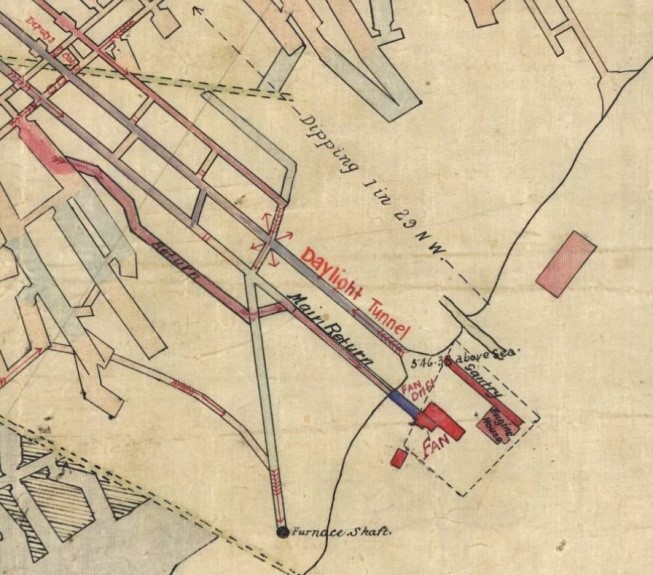
Corrimal-Balgownie Portals c. 1900
1902 – Fatality 3rd September – A miner (Robert Cram) struck by falling coal at face. Death occurred (in hospital) on 22/9/1902. Approx. 240 employees, ventilation is by a Walker fan intaking via the Corrimal haulage tunnel and the Balgowrie (sic) Daylight tunnel. (DoMAR 1902)
1902 – September 9th, Mr A.E. Pitt, secretary, the Corrimal-Balgownie Collieries Company Ltd. Notifies DoM that the Corrimal Colliery had been taken over from the Southern Coal Company Ltd. by a new company, the Corrimal-Balgownie Collieries Company Ltd on Sept 1st. (DoMAR 1902)
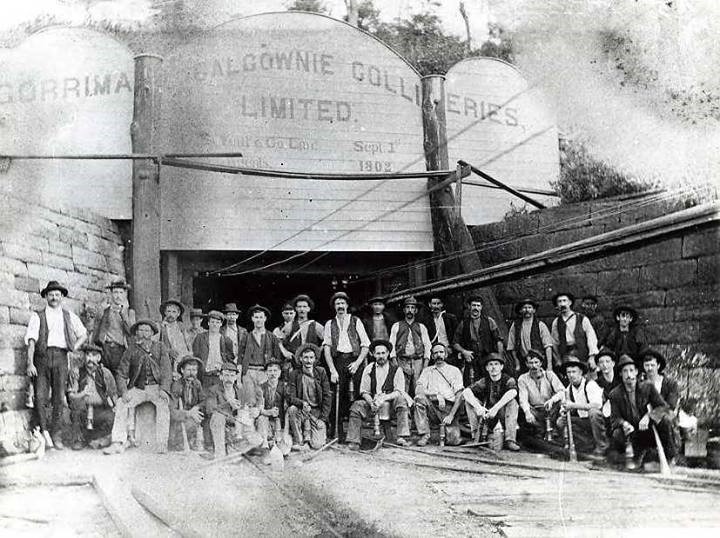
Corrimal-Balgownie Collieries – Corrimal Colliery Daylight Portal
1902 – James Thomas Watson (1872-1938) mining engineer appointed as Inspector of Collieries at Wollongong. (DoMAR 1902)
1902 – September 19th – an ignition of bottom fire-damp occurred when one of a pair of miners extracting pillars near the boundary, placed a naked light on the floor, setting fire to some old timber and bottom coal in the roof. (DoMAR 1902)
1902 – A serious fire breaks out around 3am estimated at 400 to 500 yds. u/g. Inspector Watson and Senior Sergeant Banks attended. Mr. Sellers, mine manager, was at the Mt Kembla Colliery with Dr. Robertson. (Evening News 20/09/1902 p4, ex Trove)
1902 – September 22nd – A gob fire breaks out in the old goaf on 21/9/1902 near No. 5 lift, approx. 1 mile u/g. (The Advertiser, Adelaide, SA 22/9/1902)
1902 – September 23rd – “The seat of the gob fire has been reached and apparently extinguished. The men will probably resume work on Thursday, 25th “. (SMH 23/9/1902 p6, ex Trove)
1902 – Another fire has broken out in the same goaf as before. (SMH 8/10/1902 p8, ex Trove)
1902 – The outbreak of fire has not yet been extinguished. Inspector Watson and the manager anticipate success within a week. (SMH 10/10/1902 p8, ex Trove)
1902 – An advertisement is lodged for a Colliery Manager for the Corrimal-Balgownie Colliery (SMH 15/11/1902 p3)
1902 - 1st Dec, – “Terminus of the Dips Endless Rope” shown as between panels 9 and 10 Left, some 1800 m inbye the Corrimal-Balgownie portals on a rolled linen wall plan, 2chns to 1 inch, indicating drawn c.1909.
1902 – Mr. Pendleton from Newcastle is the new mine manager for Corrimal Colliery. (Ill Mer.3/12/1902 p2)
1903 – 28th March, a large fall of coal in South Bulli Colliery near the Corrimal Colliery boundary, caused a large flow of water up to 5 ft. deep to occur. (Barrier Miner, 28/3/1903)
1903 – Henry Harrigan, carpenter, is severely injured while working in the daylight tunnel. (SMH 9/9/1903 p8, ex Trove)
1903 – Fatality 6th October – Charles Shaw, ~60, shiftman, buried under falling roof. (DoMAR 1903)
1903 - Jan 24th, Mr A.E. Pitt (Secretary Corrimal-Balgownie Coal Co Ltd) notifies DoM that Mr. W.B. Pendleton has been appointed Mine Manager from 1st January. (DoMAR 1903)
1903 – 300 employees, 184,289 tons produced. (DoMAR 1903)
1903 – 26th Aug, a fall of coal caused a miner named Albert Smithers, son of Mr. Samuel Smithers (a miner of Fairy Meadow), to sustain a compound fracture of the leg. (SMH 29/08/1903 p10 ex Trove). Connection with Smithers Tunnel? See SMH 26/06/1900
1904 – “Corrimal-Balgownie has made extensive additions to its plant plus secured some 5.5 square miles of coal lands to the west. Intention to construct a 2000 ton hopper to cater for anticipated increased production”. (SMH 28/06/1904 p5)
1904– Fatality 20th July – Edward Cockburn, 52, miner, struck by falling lump of coal (~ ½ ton). (DoMAR 1904)
1905 – A meeting with the MWS&D Board confirms the proposal to sink a ventilation shaft on block 18, at the junction of Angel Creek and Cataract River, within the catchment. (Aust. Star 24/05/1905 p6)
1905 – “It is intended to construct a tramline from the frontage, the bricks for the shaft will be made on the ground.” (SCT & W’Gong Argus, 17/06/1905, p10)
1905 – Brickmaking for the ventilation shaft is proceeding and the party of 5, have about 40,000 in stock. (SCT & W’Gong Argus 28/10/1905 p11)
1905 – November – The loco shed and w/shop are approaching completion. (SCT 25/11/1905)
1905 – Corrimal-Balgownie Colliery reported to have 280 persons u/g, 51 at the surface. Mr. Thos. Cook is listed as manager (acting) and Mr. H. Shepherd as u/manager. (DoMAR 1905)
1906 – Reference is made to a tramline having been constructed to Brokers Nose? for the construction of a shaft and being available for sightseers. (South Coast Times & Wollongong Argus, 17/02/1906 p11)
1906 – A shaft has been sunk inside the Corrimal-Balgownie Colliery in the main heading to a depth of 30 ft. (9.1m) to the 4’ ft. seam. (Ill Merc 31/07/1906 p2)
1906 – a 91 ft. (27.7m) upthrow fault encountered in the workings at Broker’s Nose so a new entrance one mile south is commenced and called the Corrimal-Balgownie Colliery.
1906 – A horse (9) drawn waggon with a load of brick making plant from Mr. Ashley’s, Wollongong, fell over an embankment on the side of the road – no major damage or injuries. Shaft sinking has not yet begun. (South Coast Times & Wollongong Argus, 18/08/1906)
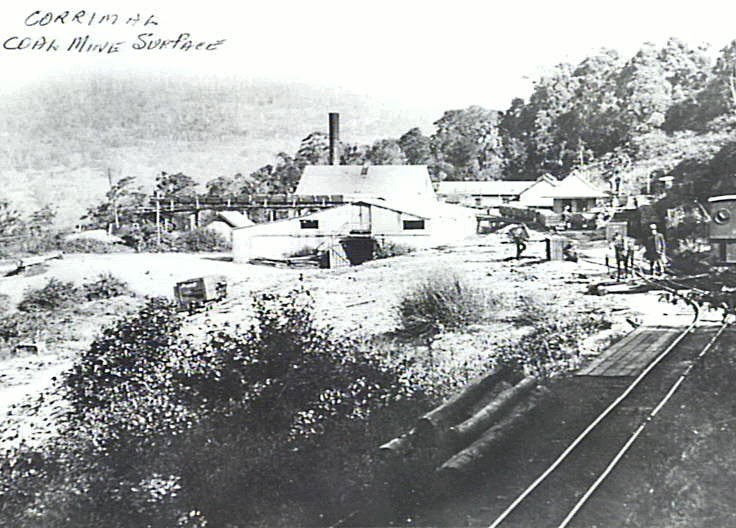
Corrimal-Balgownie pit-top (see plan)
1906 – Tenders are called for the sinking of a ventilation shaft (SMH 20/09/1906 p1)
1906 – Brickmaking has been going on at this spot for the last 12 months (SCT & W’Gong Argus, 22/09/1906)
1906 – Nov. 2nd notification to DoM by Manager W.B. Pendleton that work had commenced on a ventilation shaft for the Corrimal-Balgownie Colliery. (DoMAR 1906)
1906 – Mr. T. Beecham secures the contract to sink the 900’ (274m) deep Corrimal-Balgownie vent shaft (Ill Merc 2/11/1906 p2)
1906 – W.B. Pendleton and H. Shepherd listed as Corrimal-Balgownie Mine manager and u/m respectively (DoMAR 1906)
1906 – “The first sod of the sinking of the ventilation shaft into Corrimal Colliery at the rear of Broker’s Nose to a depth of 900 ft. was performed this week in the presence of a large gathering”. (Aust. Town & Country Journal, 7/11/1906)
1906 – Over 40 men are now employed on sinking the new shaft. Water was struck at 20ft. (Ill Merc 9/11/1906 p2)
1906 – The ventilation shaft at Corrimal is now down to 50 ft. Contractor Mr. Beauchamp. (SMH 19/11/1906, p7)
1906 – “Colliery owned by Corrimal-Balgownie Collieries Limited, 45 miles from Sydney. The area owned and leased is 8748 acres. Coal is the Bulli seam, 7’ – 8’6” of steaming coal, outcropping under Brokers Nose at 375’ asl and worked by adit. Workings are some two miles from the adit with an output of 800 tons/day, using bord and pillar system by some 350 miners. The company owns 120 hopper wagons of 7 to 9 ton capacity and 4 locomotives all of NSW Gov. Railway standard. Coal drawn to surface by endless rope operated by 5 multitubular and Cornish boilers. After passing over the weighbridge the skips are carried on a 40 chain self-acting endless rope incline to the screens 355’ vertically below where upon being sized is taken by loco to Pt Kembla, Wollongong, Bulli or Bellambi. Mine ventilation is by a Walkers Bros 12’ diameter x 5’ wide Indestructible fan connected by rope gearing to a steam engine having a 14” diameter cylinder with a 2 ½ ft. stroke producing 80,000 cfm at 1.5” w.g. the engine operating at 50 rpm. A 850’ d/c ventilation shaft has been commenced. Safety lamps are used throughout the mine. A power plant at the mine supplies power to the workshop, lamp cabin and various u/g stations. The stables accommodate 50 horses and are electrically lit. A large locomotive shed and workshop (lathes, planers, wheel turning etc.) is established at Unanderra, 6 ½ miles from the tunnel mouth. The company supplies the bunker requirements for numerous steamship lines including the Adelaide Steamship Co. with large quantities exported to Melbourne, Adelaide and Western Australia as well as Hong Kong and Singapore. The small coal is converted to coke at the Australian Coke Making Co. Ltd at Unanderra for smelters at Broken Hill, Mt Morgan and Chillagoe etc. with exports to San Francisco and Japan. The Colliery Manager is Mr. W. H. Pendleton the u/manager is Mr H. Sheppard. G. S. Yuill and Co. Ltd are responsible for the general management of the colliery and the sale of the coal.” (Abridged from an article in the South Coast Times and Wollongong Argus, 8/12/1906, p4)
1906 – Fatality 20th December – Leslie C. O’Connor, 15 yrs, brake boy, became entangled in the endless rope wheel at the top of the incline, and is cut in half. (DoMAR 1906)
1906 – The ventilation shaft at Corrimal is now down to 100 ft. (Ill Merc 28/12/1906, p1)
1907 – “Ventilation is provided by a Walker Brothers Indestructible fan. 12 feet (3.66 m) in diameter by 5 feet (1.52 m) wide connected by rope gearing to a flywheel of an engine with a cylinder 14 inches (355.6 mm) in diameter with a 2.5 feet (0.76 m) stroke. The fan is producing 80,000 cfm at 1.5” w.g. with the engine running at 50 rpm. Capable of providing double this quantity, the commencement of the sinking of a new ventilating shaft to act as an intake will further assist”. (The Cyclopedia of NSW, 1907)
1907 - The ventilation shaft at Corrimal is now down to 160 ft. with 140 ft. already bricked. Continuous pumping is necessary. (Ill Merc 19/2/1907, p2)
1907 – On 2nd March two sinkers at the Corrimal shaft were overcome by foul air after firing a round of shots. (The Advertiser, 5/3/1907 p7)
1907 – Company holdings consisted of 1,254 acres freehold and 8,117 acres mineral leasehold. Granted a further 7,423 acres plus a lease of 604 acres partly worked by Mt. Pleasant Colliery.
1907 – Apr 29th – Some 70 yards of the Bulli Colliery and Coke Works jetty collapsed when 40 fully laden wagons from Corrimal-Balgownie Colliery were shunted onto the jetty. 15 iron hoppers were dumped into the sea. (The Advertiser, Adelaide, 30/4/1907)
1907 – Jun 8th - Advertisement for “First Class Sinkers required” (SMH 8/6/1907 p18)
1907 – Shaft down to 350’. Progress slow due to water. (SCT & W’Gong Argus 31/08/1907 p13)
1907 – Sep 9th – [Corrimal No. 1 Shaft] Advertisement for “Competent Sinkers for Ventilating Shaft at Corrimal” (SMH 9/9/1907)
1907 – Corrimal Shaft at 450 ft. (Ill Merc 8/10/1907)
1907 – Ventilation shaft down to 540’. G. Masters takes over sinking contract after men strike in November due to “conditions”. (SCT & W’Gong Argus 07/12/1907 p12)
1908 – Scarcity of water in district. Mt Pleasant & Corrimal mines down to 1 x month’s supply. Macquarie Rivulet (Albion Park) has ceased to flow. (SMH 11/01/1908 p13)
1908 - Dec. 28th notification to DoM by Manager W.B. Pendleton that Mr H.J. Shepherd had been appointed manager of the Corrimal Sinking Pit. (DoMAR 1908)
1908 - Shaft down to 700’. (SCT & W’Gong Argus 07/03/1908 p13)
1908 – Apr 6th – The new air shaft strikes coal at 780 ft. (SMH 6/4/1907)
1908 – First 2’-0“gge steam loco is purchased by colliery. Is this used on the 1906 link between Corrimal-Balgownie and Brokers Nose replacing horses? (K. McCarthy, “The Corrimal Colliery Railway”, 1978)
Corrimal No.1 Shaft:
1908 – Notification that a shaft some 800 ft. deep had been completed on the Corrimal-Balgownie property and may be eventually used as an upcast shaft. (DoMAR 1908)
1908 - Fatality 7.00 a.m. 2nd Jun, M. O’Dowd, 60, miner, slipped in the travelling road on 10th Jul. 1907 injuring wrist. He died from neuritis resulting from the accident. (DoMAR 1908)
1908 – Jun 20th – “The laying of pipes from the new shaft through the Corrimal mine out through Daylight Tunnel, a distance of some 2 ¼ miles, was completed yesterday. The water is now forced out by gravity instead of pumped out as previous” (SMH 20/6/1908)
1908 – Jul 18th – “The bricking of the archways of the shaft was completed yesterday. Two hydraulic pumps are to be placed at the foot of the shaft for the purpose of forcing water up to lodgement from there to run by gravity to the daylight tunnel” (SMH 18/7/1908)
The Corrimal No 1 Ventilation Shaft was sunk on the western boundary of freehold land, 2.78 km from the mine pit top. The shaft was 14’ (4.27m) diameter with a depth of 791’ 8” (241.3m) to the roof of the Bulli coal and 832’9” (253.8m) to the roof of the Balgownie coal. The shaft was lined with 9” brickwork, the space behind the bricks filled with ashes. Bricks were made on site being laid after the temporary wooden lining was removed approximately every 60 ft. A wooden headframe was utilised and is still in place today (2017) having been refurbished c. 1991 by BHP.
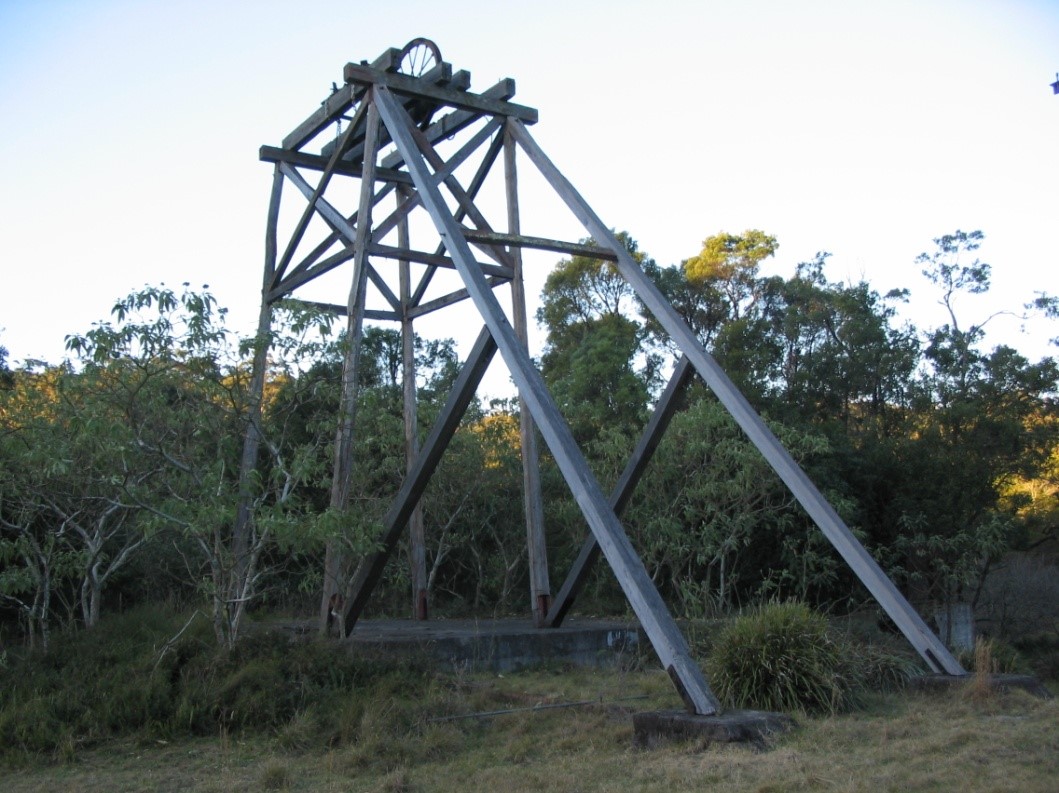
Corrimal No. 1 Shaft Headframe c. 2005
1909 – George Mason Hindmarsh is appointed Colliery Surveyor.
1909 – “The Corrimal-Balgownie line for the conveyance of the men to their working places in the mine – some 2 miles – is nearing completion”. (SMH 15/2/1909, p4)
1909 – Listed: Shaft depth 792 ft. diam. 14 ft. No cage listed. (DoMAR 1909)
1909 – Report of 5 children lost in bush west of Corrimal/Broker’s Nose – W.R. Pendleton, manager Corrimal mine offers search volunteers conveyance up the incline on the tramline. (Ill Merc 31/12/1909 p4)
1910 – James Thomas Watson (1872-1938) is Colliery Manager. (Australian Dictionary of Biography – online edition)
1910 – Reference is made to a group of visitors walking up to the mine site then being transported by trolley to the top of the mountain from Corrimal Colliery (South Coast Times & Wollongong Argus, 20/05/1910 p10)
1910 – Mr James Robertson is appointed assistant manager of Corrimal Colliery (SMH 2/7/1910)
1910 – Fatality 8.30 a.m. 5th September, Christopher Martin, 26, miner, crushed between a skip and the face. (DoMAR 1910)
1910 – Installation of an electric plant for coal cutting and auxiliary haulage. The plant consisted of a Bellis-Morcom 225 HP compound vertical enclosed high speed engine, direct coupled to a British Westinghouse 2,300 volt, 160k.w. generator, its exciter being mounted on the extended engine-crank shaft. Steam supplied from two Babcock-Wilcox boilers, each having 2,010 square feet heating surface, fitted with superheaters, and working at a pressure of 150 psi.
The power is transmitted into the mine by means of 19-16 Callander 3-core h.t. copper cable, paper insulated, lead sheathed and steel armoured to a point about 1 ¾ miles from the mines entrance where it was proposed to form a sub-station and to transform the pressure to 230 volts.
It was also proposed to install a Reavell quadruplex air compressor at this station having a 12” stroke and capable of 370 cfm at 70 psi. Belt driven by a 230 volt, A.C. , 73 b.h.p. motor. The compressed air will drive two Siskol (1910 model) coal cutting puncher machines. (DoMAR 1910)
c.1911 – Snapshot in time ex F. Danvers Powers, (1912);
Worked by Southern Coal Co until 1891 when Corrimal-Balgownie Collieries was formed. Formerly two separate collieries but now (1911) connected.
Balgownie: - main haulage and intake with a return on the RHS. On the LHS is an ex-return now an intake.
The return is via old workings to the 14 ft. Indestructible Walker’s Fan, pulling 85,000 cfm @ 1.7”wg but now with the shaft connected 110,000 cfm @ 1.5” w.g. The fan is powered by an engine with 16” diameter piston having 2.5 ft. stroke.
Corrimal: - single heading as intake, fitted with grille that is lowered when pit is idle.
The shaft is downcasting but will revert to upcasting shortly.
The men enter via the Balgownie tunnels to access both mines. Coal is transported out via the Corrimal portal to a self-acting incline.
The 90 ft. slide (fault) between the Balgownie and Corrimal mines is negotiated by an endless rope via a 1:3.5 drift.
The Balgownie pit top has two Cornish boilers plus one locomotive style multi tube boiler.
Water from the Corrimal #1 Shaft is delivered to the surface via the Daylight Portal through some 9,000 ft. of pipeline.
1911 – 26th May, Mr. J. T. Watson is appointed Manager. (DoMAR 1911)
1911 – 25th Nov, Mr. O. B. Green is appointed Electrician. (DoMAR 1911)
1911- End of year - Corrimal No. 1 Shaft fitted with a 91” Sirocco double inlet, 150HP electric motor, rope driven fan. (DoMAR 1911)
1912 – May, Corrimal Cokeworks commissions C1 battery (40 ovens near Corrimal Railway station).
1912 – The notification of a new tunnel into the Bulli seam commencing (22nd Jun) and the sinking of a small ventilating shaft (2nd Oct) were delivered to the DoM. (DoMAR 1912)
1912 -29th Aug, Mr. A. Dixon is appointed Undermanager. (DoMAR 1912)
1912 -29th Nov, Mr. P. A. Cooke is appointed Electrician. (DoMAR 1912)
1912 – September - Official opening of the Cokeworks. Waste gases utilised to produce electricity to power its machinery and also the mine.
1913–23rd April, J. T. Watson, Manager of Corrimal& Balgownie Collieries has accepted the management of Chillagoe Co.’s Mt Mulligan, assuming duties in May. (Cairns Post 23/04/1913)
1913 – 12th May, Mr. C. W. Dixon is appointed Manager. (DoMAR 1913)
1913 – 17th Jul, Mr. H. Shepherd is appointed Undermanager. (DoMAR 1913)
1914 – 4th May, Mr W. B. Pendleton is appointed Manager of Corrimal colliery.
1914 – 1st Jun, Mr W. Jones appointed Manager of Corrimal colliery. Son of Mr C.J. Jones, manager of Coal Cliff and Mt Keira mines. (The West Australian, Perth, 11/6/1914)
1914 - George Mason Hindmarsh appointed as Undermanager (enlisted in AIF 1916).
1914 – 1st Dec an u/g fire occurs in a compressor extinguished by buckets of water. (DoMAR 1914)
1915 – A seven week strike over cavilling conditions is settled; work to resume 4/5/1915, loss in wages approx. £500 (SMH 2/5/1915)
1915 – 6th Jul, W. J. Gaynor appointed as Electrician (DoMAR 1915).
1915 – The management of Corrimal colliery dismisses all German employees under the threat of refusal to work by the men. (Barrier Miner, Broken Hill, 30/5/1915)
1916 – 30th Mar, Mr. W. Rawlings is appointed Under manager Vice Mr Hindmarsh (DoMAR 1916)
1916 – 23 full and 14 empty skips were allegedly, wilfully let loose at the Corrimal mine running down the incline and causing £50 damage and considerable delays to operations. (SMH 18/10/1916)
1916 – The majority of Sth Coast mines restart after a month’s strike (SMH 5/12/1916)
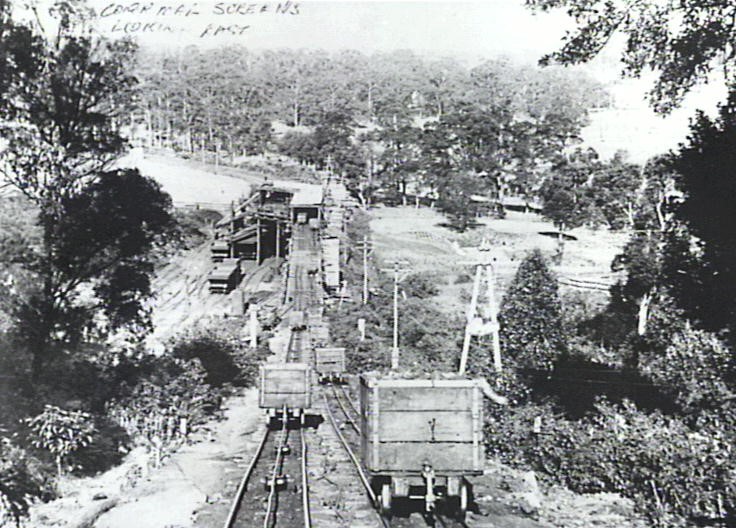
Old 2’-0” incline (in operation until c.1955)
1917 – Fatality, 2nd Jul, Thomas Stevenson, 15, rope boy, run over by some skips and killed. The boy was occupied in retrieving some sprags from the rib near 3 North shunt. (SMH 11/7/191); (DoMAR 1917)
1917 – Corrimal-Balgownie Coal Co. Secretary- R.G. Bloomfield; Manager- W. E. Jones; U/Manager- W. R. Rawlings 254 employed u/g; 90 above ground. (DoMAR 1917)
1917 – 21st Nov - Mr T. Cook is appointed Mine manager during Mr. Jones’s absence. (DoMAR 1917)
1918 – 254 employed u/g; 90 above ground (DoMAR 1918)
1919 – 25th Jan – Notice of a new tunnel being driven for Corrimal-Balgownie Colliery (DoMAR 1919)
1919 – Fatality, 18th Jun, James Cooper, 52, miner, killed while drawing timber (DoMAR 1919)
1919 - 280 employed u/g; 90 above ground George Mason Hindmarsh resumes his duties as Undermanager. (DoMAR 1919)
1920 – Corrimal Balgownie Colliery is listed as having; Mine Manager; Mr. W. E. Jones, U/Manager; Mr. W. J. Hawke. Ventilation; Intakes, 1 x Adit, 11’x 7’6”, 1 x Adit, 10’x 8’, 1 x Adit, 8’x 7’6”. Return, No. 1 Shaft, 14’ diameter x 780’ deep, with a 91” Sirocco fan pulling 114,400 cfm. (DoMAR 1920)
1920 - 280 employed u/g; 90 at the surface (DoMAR 1920)
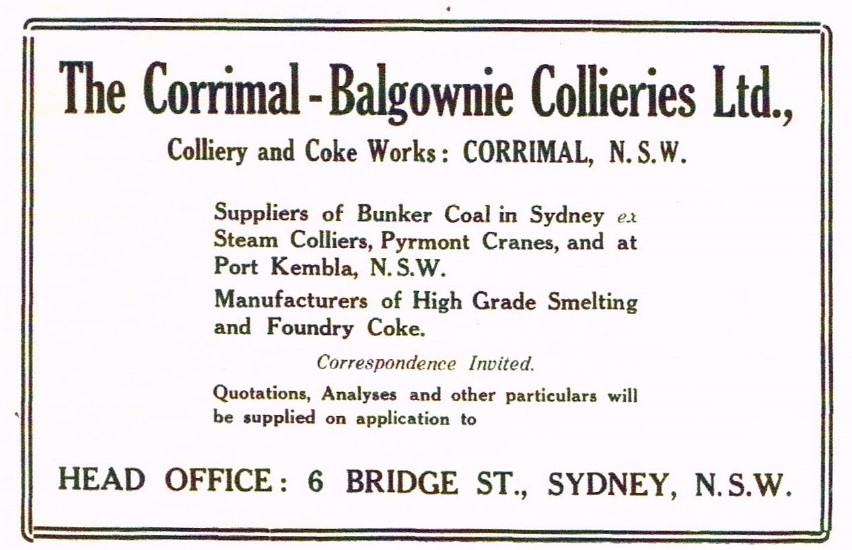
Advert from “Australian Coal, Shipping, Steel & The Harbour” 01-01-1921
1921 – Corrimal-Balgownie No. 2 Colliery opens in the Balgownie seam RT7A (DoMAR 1921)
1921 – Corrimal-Balgownie No. 2 Colliery furnace shaft heading indicate to have been complete on 25/11/1921 directly “over/under” the stub heading of previous Bulli seam workings?
1922 – “Corrimal-Balgownie Collieries Ltd have applied for 31 acres, 0 roods, 271/2 perches for mining purposes, Parish Cordeaux, Co Camden, for the purposes of sinking a shaft and the erection of barracks for employees, erection of an engine room, store and other works incidental to sinking a shaft; also a tramline and electrical transmission line and for a stream water right area.” (Ill Merc 17/02/1922 p3)
1922 – Corrimal-Balgownie employs 285 u/g and 90 above; No.2 Mine has 6 u/g and 1 above. The colliery is busy constructing a tramway between No 1 and the proposed No 2 shafts. (DoMAR 1922)
1923 – Construction of a surface tramway west from Corrimal No. 1 Shaft to site of proposed Corrimal No. 2 Ventilation Shaft has been completed. (Used to supply materials etc. via the underground workings and No. 1 shaft). Sinking gear is being moved onto the site. (DoMAR 1923)
1923 - 287 employed u/g; 92 above ground (DoMAR 1923)
1923 – RT7A dated 18/01/1923, shows the Corrimal-Balgownie No. 2 Colliery workings complete with faces surveyed and measured as at 30-09-1922. The brick lined furnace shaft is marked as 9 ft. (2.7432m) internal dia. (measured at 6.5m deep during an inspection in 2013- B.S.)
1924 – An undated plan indicates that no change to the Corrimal-Balgownie No. 2 Colliery faces between 30/09/1922, 31/12/1922, 31/12/1923 and 30/06/1924.
1924 – 284 employed u/g; 104 above ground; Sinking of No. 2 shaft commenced at the beginning of year. To be brick lined surface to seam. 6 men employed u/g with 10 above ground. (DoMAR 1924)
1924 – Mr. J. S. G. Worland reported as being the Colliery Surveyor. (Ill Merc.11/07/1924 p9)
1924 – “A tramline has been completed from the present u/c shaft (#1) to the site of the new ventilation shaft (#2) and a start made in preparation to sink. Accommodation is being provided, huts having been procured from Holdsworthy (sic).” (SCT & W’Gong Argus 22/08/1924 p2)
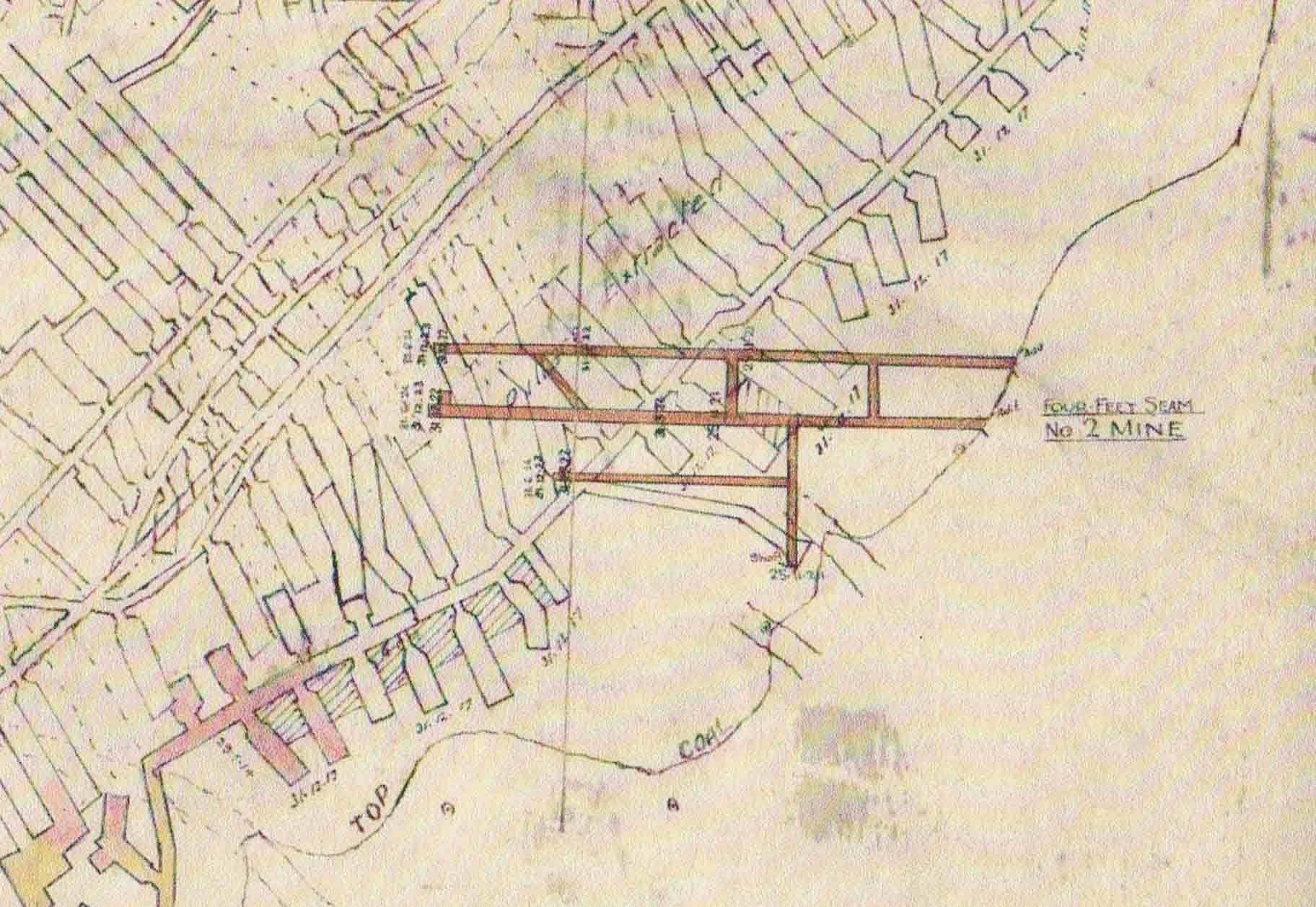
Corrimal-Balgownie No. 2 Colliery – extent of workings under Brokers Nose Mine
Corrimal No. 2 Ventilation Shaft:
1925 – Corrimal No 2 Ventilation Shaft sunk near most westerly workings, 17 ft. (5.2m) dia 1,126 ft. (343.2m) to the Bulli coal continuing to 1,172 ft. (357.22m) that is 12ft below the Balgownie coal.
1925 - 284 employed u/g; 146 above ground; Sinking of No. 2 shaft employs 24 men u/g with 18 above ground. (DoMAR 1925)
1926 – Advert: - Tenders called for Shaft sinking contract; 400’ x 17’ brick-lined. (SMH 13/02/1926 p3) ??
1926 – CMRA (Amend) Act 1926 – “Furnaces are prohibited in all new mines except where less than 20 men are employed underground”
1926 – Sinking of the #2 shaft was completed 19th Oct 1926, currently in-taking only 20,000 cfm. 314 employed u/g; 116 above ground (DoMAR 1926)
1926 – Several hundred acres of bush west of and adjacent to the Corrimal Colliery is destroyed by bushfire on Monday, 18th Oct. (Ill Merc 22/10/1926 p15)

4 foot seam (Balgownie) entrance - Aug 1926
1927 – July – Electricity reaches the North Illawarra council area from the Corrimal power house, initially supplying 400 street lamps.
1927 – 294 employed u/g; 103 above ground; No workers listed as being in Corrimal-Balgownie No. 2 Mine. Corrimal No. 2 Shaft was supplying 100,000 cfm (47 m^3/s) of air to the mine.
1927 – DoM receives notice of re-commencement of Corrimal-Balgownie No. 2 Colliery. No work except the reconditioning of roadways was undertaken this year. (DoMAR 1927)
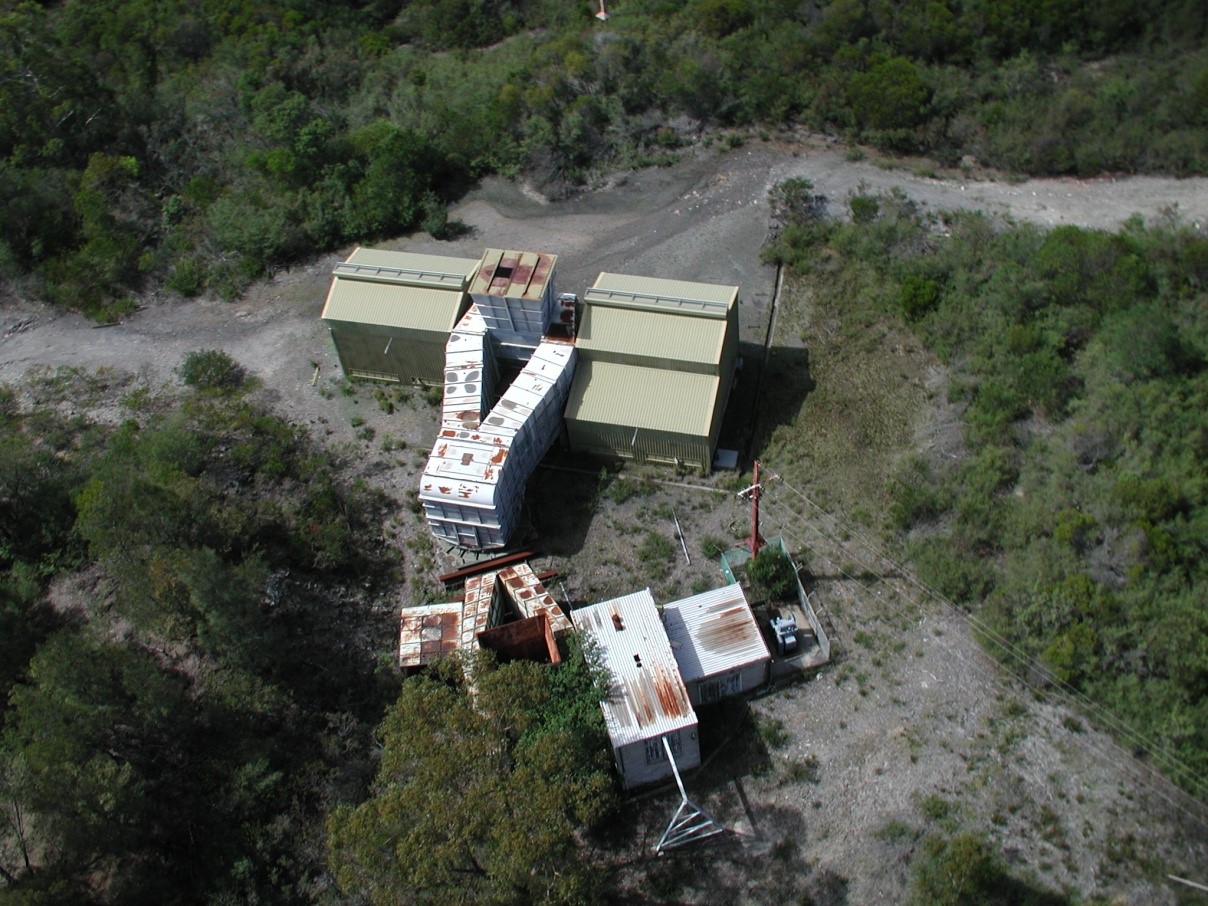
Corrimal No. 2 Shaft c. 2003 (original evasèe lower centre) prior to rehabilitation
1928 – Fatality George Stewart due to fall of roof 24/9/1928 (Worker, Brisbane, 26/9/1928)????
1928 - 310 employed u/g; 110 above ground. (DoMAR 1928)
1928 – The new bath house at Corrimal is said to be the best in NSW. A brick building with hot and cold showers and individual lockers. (Ill Merc. 16/3/1928, p13)
1929 – Mr W.B. Pendleton of Tarrawanna, ex mine-manager Corrimal Colliery dies at 79 yrs. (SMH 6/7/1929)
1929 – Fatality – Robert Kilpatrick suffered accidental death on the surface railway. (DoMAR 1929)
1930 – Safe stolen from the colliery pit top office, loaded onto skip, and broken open some quarter mile along the tramline. £30 stolen plus loose change from unclaimed pay packets, notes left intact. (SMH 15/7/1930)
1930 - C1 coke battery extended by a further 10 ovens.
1935 – Fatality W. Wilson, Deputy, 29/05/1935 suffered a “heart attack” whilst assisting to re-rail skips at a haulage crash site. Died 14/07/1935. (DoMAR 1935)
1936 – Check Inspector reports that the ventilation at Corrimal is “pretty bad”. (SCT 19/6/1936 p9)
1937 – Corrimal mine resumes work after a strike lasting 3 weeks (SMH 4/5/1937)
1937 – George Mason Hindmarsh appointed Superintendent of A.I & S Collieries.
1937 – Corrimal-Balgownie Collieries Ltd., changes name to Corrimal Coal and Coke Pty Ltd. (SMH 24/5/1937)
1938 – The funeral of ex colliery manager, Mr. Alfred Ernest Oswald Sellers (SMH 17/11/1938)
1938 – Listed as having electric motors powering 2 fans, 7 pumps and 3 haulage engines. (DoMAR 1938)
1938 – Inspection of the Corrimal Colliery mine workings leads to the check inspector stating that some of the working faces were unfit to work due to excessive dust and sluggish ventilation. Recommends that “chocolate shale dust be suspended for stone-dusting. (Ill Merc 18/11/1938 p6)
1939 – Electric Coal Cutter and electric Borer installed. Hand filling of coal is replaced by mechanised means.
1942 – The War cabinet reviews latest strikes by NSW coal miners, this time over the use of mechanical conveyors. (Morning Bulletin, Rockhampton, 11/3/1942)
1942 – Corrimal Colliery idle for approximately 1 week due to concerns over gas even though the Chief Coal Mines Inspector declares it safe. (Newcastle Herald 12/3/1942 p4)
1943 – 350 miners at Corrimal Colliery resume work after a month on strike (Canberra Times, 27/2/1943)
1943 – Henry Bryan Campbell is current mine manager.
1945 – Ref in the obituaries section of the S C Times to a Mr. & Mrs. Leonard Critcher of No.2 shaft, Corrimal Colliery and the death of their infant daughter Christina. (SCT 2/2/1945 p7)
1945 – Corrimal Colliery on strike because a miner thought he had lost his watch, later found in his hip pocket. Loss of 900 tons production. (The Mercury, Hobart, 13/4/1945)
1945 – a new sub-station at the mine site was built and all power requirement taken from P. W. D. supply via a 33,000V line.
1946 – Reported as working 210 days during 1946 (DoMAR 1946)
1949 – circa – Corrimal No. 2 Shaft converted to upcast by the installation of a 96” (2.43m) Hi Flow fan with a 250 HP electric motor. No. 1 shaft converted to a downcast shaft. (Illawarra Heritage Trail)
1949 – Fatality William Albert Baietto, watchman, collapsed and died from natural causes while on duty. (20/07/1949) (DoMAR 1949.)
1950 – Fatality Alfred Henry Hansen, electrical mechanic, crushed between a battery loco and brick wall in the u/g charge bay (28/09/1950) (DoMAR 1950.)
1950 – Fatality William Davies, electrical mechanic, fall from ladder on surface. (09/12/1950) (DoMAR 1950.)
1951 – Fatality Robert Kerr, shunter, crushed between 2 wagons at the screens. (08/08/1951) (DoMAR 1951.)
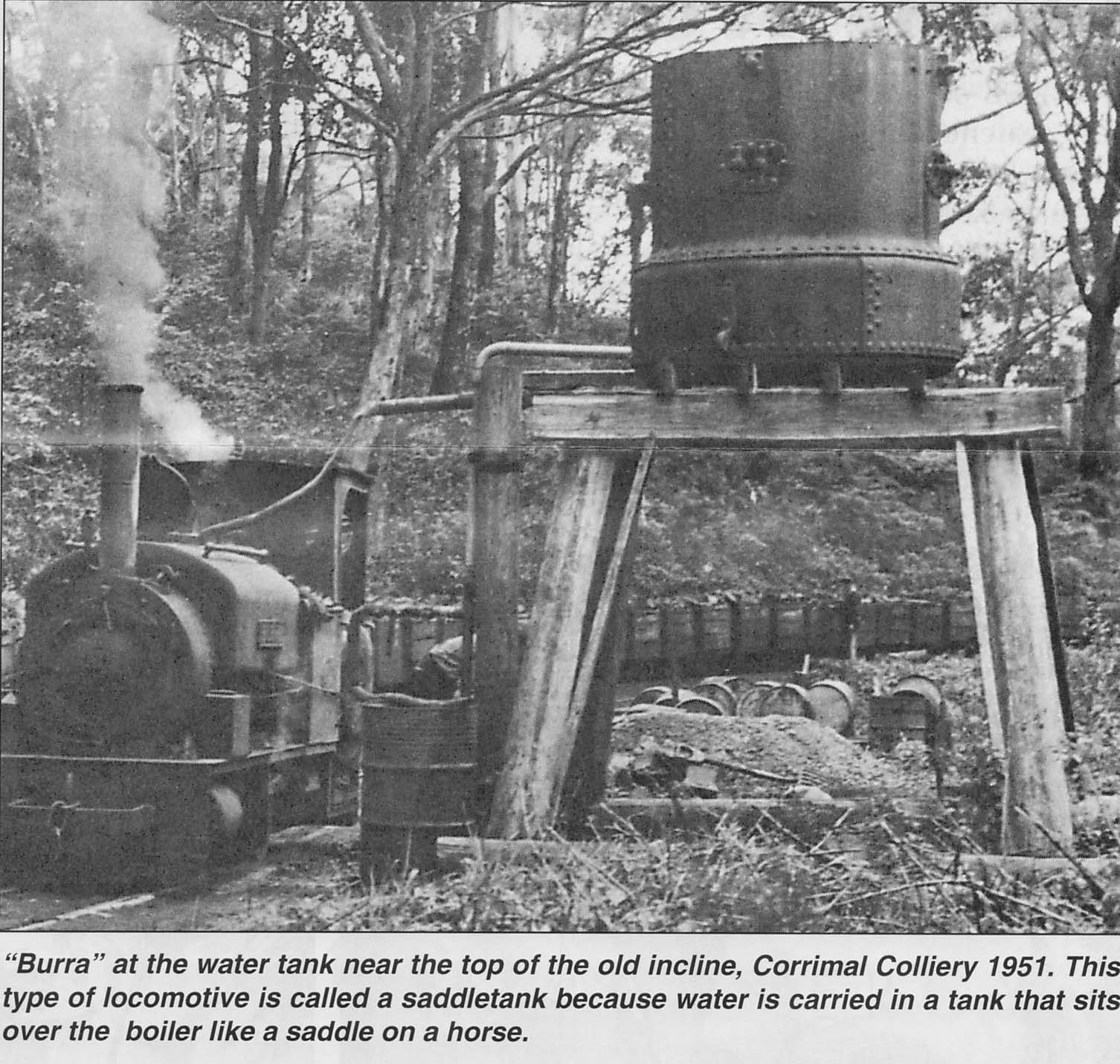
1951 – Article – Corrimal Coal & Coke Pty Ltd – “Corrimal Colliery was started in about 1887 by Thomas Bertram (as the Brooker’s Nose Colliery)……The Corrimal Colliery has two airshafts; One No.1 about 1-3/4 miles from the tunnel mouth, 14’ x 780’ used as an upcast, completed ~1908; the second, No 2 further west sunk in ~1927 17’ x 1100’ used as an intake (d/cast)” Implies no fan! (SCT & W’Gong Argus 14/5/1951 p3)
1952 – Corrimal mine is idle (9/4/52) due to ventilation issues. (Ill Merc 10/4/1952 p5)
1953 – Fatality Cesare Pozzer, 23, thrown from a transport car that failed to take a curve on 22/1/1953 (SMH 23/1/1953)
New Incline:
1955 – The new 3’-6” self-acting incline installed from Corrimal - Balgownie pit top eliminates the need to haul the coal north to Broker’s Nose Colliery then down a 2’-0” incline.
1957 -
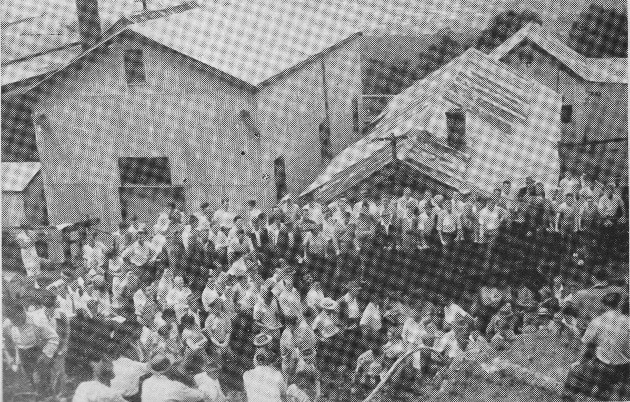
Oct, 1957. Stay-in Strike. Part of crowd of 1,000 at tunnel mouth supporting the stay-in men.
(Thanks to the Memorial Booklet at the official opening of the “Miner’s Federation Offices” Wollongong, Aug, 1962.)
1959 – [Corrimal Coal & Coke Pty Ltd]. Fully mechanised. A continuous miner and mobile roof bolter introduced. Production averages 700 ton/day hauled to the surface via an endless rope system. (DoMAR 1959)
1960 – Completion of a new bath and change house at the washery.
1962 – C2 Coke ovens battery commissioned adding 32 ovens.
AI&S purchases Corrimal Colliery:
1964 – March – A.I.S. Pty Ltd. purchases Corrimal Colliery and Corrimal Cokeworks. Endless rope haulage system replaced by 1.07 m gge track with diesel personnel cars for man transport.
1965 – March – Harry Marsh becomes Mine Manager.
1965 – All coal now diverted to Mt. Kembla via the Kemira Tunnel eliminating the need for the old surface railways and inclines.
1965 – Fatality Ronald Cedric Linsley, electrician, electrocuted at Corrimal Washery (27/10/1965) Colliery Records.
1966 – Fatalities – Edmund Hillam, Shiftman & William Neaves, (21 yrs.) u/g labourer by injuries suffered in an intersection fall. (12/04/1966) Colliery Records and DoMAR 1966.
1966 -> 1969 – conveyors installed to transport all coal via Kemira Tunnel.
1966 – The endless rope man transport haulage system is removed and replaced with diesel man cars.
1967 – Installation of the transfer system and coal bins to transport all Corrimal coal via Kemira is completed. The 1 ton skip haulage system over 3 miles is dismantled with associated surface installations. The area used for the haulage engines and skip turn around will be utilised for a new workshop.
1967 – Outbursts were encountered during the driveage of 2 South West district, 23rd, 31st October and November 22nd with the expulsion of flammable gas. No injuries were sustained. (DoMAR 1967)
1968 – Large diameter (12”) boring equipment, to be used to drill up to 60’ ahead of the face to alleviate risk of an outburst, was borrowed from Metropolitan Colliery. (DoMAR 1967)
1968 – October - A 3,300 V Marietta borer miner commences operations equipped with a Bacharach methane monitor.
1968 – The original 250 HP fan at #2 Shaft is replaced by a 500 HP fan, an airfoil centrifugal installation extending west of the shaft.
1969 – The “high voltage” Marietta miner is withdrawn from service as unsuitable for high stress areas requiring close face support.
1969 – Bellambi Coal Company purchases Corrimal Cokeworks sourcing coal from its Sth Bulli Mine.
1969-70 – Large diameter boreholes ahead of the face being used for stress and outburst gas relief. No. 3 Shaft sinking commenced with the headframe and winding gear being installed.
Corrimal No.3 Shaft:
1970/71- Corrimal No 3 Shaft sunk for D/cast ventilation. 5.5m dia. concrete lined, 388.5 m to the Bulli coal floor with a total depth of 436m (16m below the Wongawilli coal floor).
1971 - Fatality Ian Fergusson Cannon, electrical mechanic, injuries suffered in a roof fall triggered by a derailed electric loco. (7/03/1971) Colliery Records.
1971 - Fatality Barry Brian Stevenson, shiftman, during the installation of roof supports. (7/05/1971) Colliery Records.
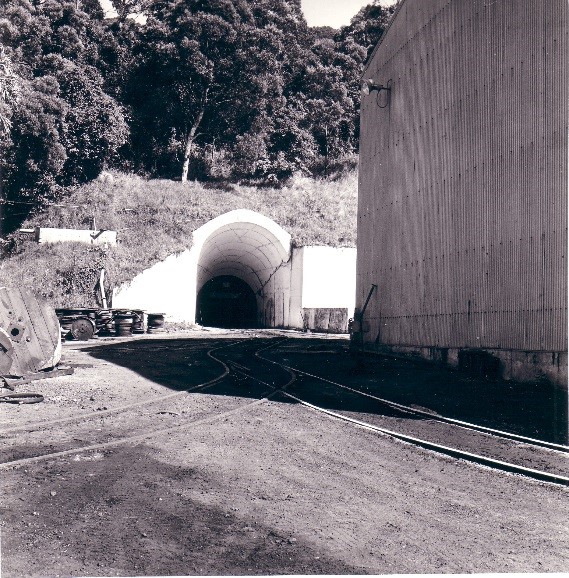
Diesel Man Transport Entry ca. 1970
1971-72 – No. 3 Shaft is being extended some 46m below the Bulli seam to form pockets for coal winding. A shortwall extraction unit using Wild 3 legged chocks was introduced.
1973-74 – One shortwall unit in operation with a second set on order. Work proceeding on equipping No. 3 Shaft for coal winding. Max velocity mid shaft is 8.1 m/s so as an additional precaution hydraulic, final overwind buffers, are fitted. (Ayre, T. G. - BHP Technical Bulletin Vol 23 N.2 Nov 1979)
1975 – A new set of Westfalia chocks received for use on the shortwall.
1975 – Corrimal No. 3 Shaft Bulk Coal Winder commissioned utilising road haulage. 600 tph in 15 t
cycles.
1975-76 – Pillar extraction continues using the Wongawilli system. Experiments are undertaken with resin anchored roof bolts. Short wall #6 being worked, the continuous mine used is operated by remote control. The coal bin linking Corrimal and Kemira collieries is filled in to re-establish the barrier.
1976-77 – All continuous miners are fitted with methane monitors and return airway monitoring introduced. Coal winding by automatic bulk winder at #3 shaft is now fully operational.
1979 – Fatality Raymond Neville Steain, machine man, by fall of stone at the face during roof bolting. (14/06/1979) Colliery Records.
1980 – Longwall mining replaces shortwall, using a shearer and face conveyor from Appin Colliery and new Dowty 4 leg chock shield supports fitted with electro-hydraulic remote control.
1980 – Fatality Emmanuel Bradford, asst. mechanical engineer, struck by pressure fitting whilst working on a DMC. (21/08/1980) Colliery Records.
1980 – Bellambi Coal Co is taken over by Australian Coal & Coke Pty Ltd.
1981 – Corrimal No. 2 Shaft fan replaced by a Davidson centrifugal driven by 2 x 500 HP, 490 rpm, EAI slip ring electric motors from Appin Colliery. Commissioned 19/12/1981. Longwall development continues.
1981 – December – Harry Marsh (Manager) leaves Corrimal Colliery
1982 – Roof bolting as sole support in newer districts.
1983 – Fatality Ronald Edward Burns, shiftman, struck by roof fall. (30/04/1983) Colliery Records.
1984 – Corrimal Coke Co. purchased by Illawarra Coke Co. Pty Ltd, a subsidiary of KCC.
1984/5 – record coal production using a Mitsui Miike Shearer, Dowty face conveyor and stage loader, Klockner crusher and Dowty electro-hydraulic chocks. (e. g. Dec/84 – Daily production 11,112 tonnes; Nov/85 – Daily L/W production 10,410 tonnes))
1985 – 10.58 am November 8th Corrimal Colliery is holed by Flinders 2 Panel, Cordeaux Colliery thus linking the two collieries.
1985 – Dec – Corrimal Colliery closes.
1986 – January – Corrimal Colliery pit top closes, the mine now having been amalgamated with the new Cordeaux Colliery.
1986 – A production crew from Cordeaux Colliery commenced the driveage of a “Tourist Mine” some 40 metres inbye the Corrimal Colliery transport portal – abandoned after 75 metres due to poor roof conditions.
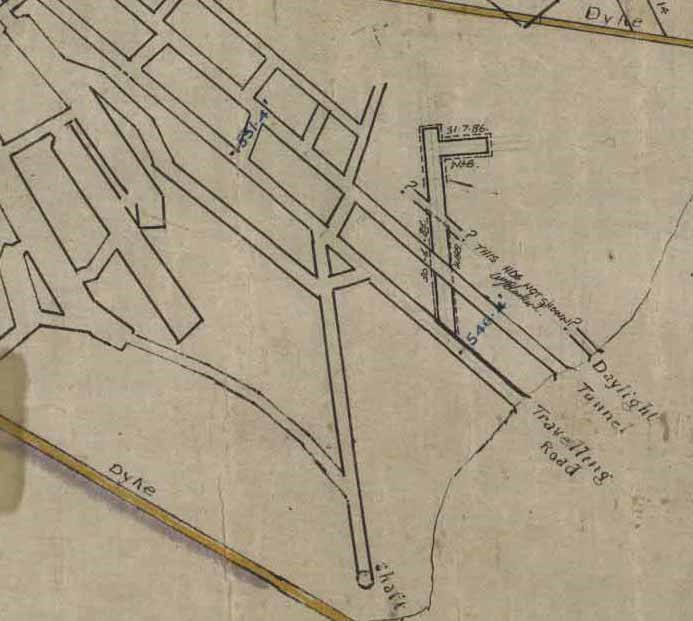
Tourist Mine drivage - 1986
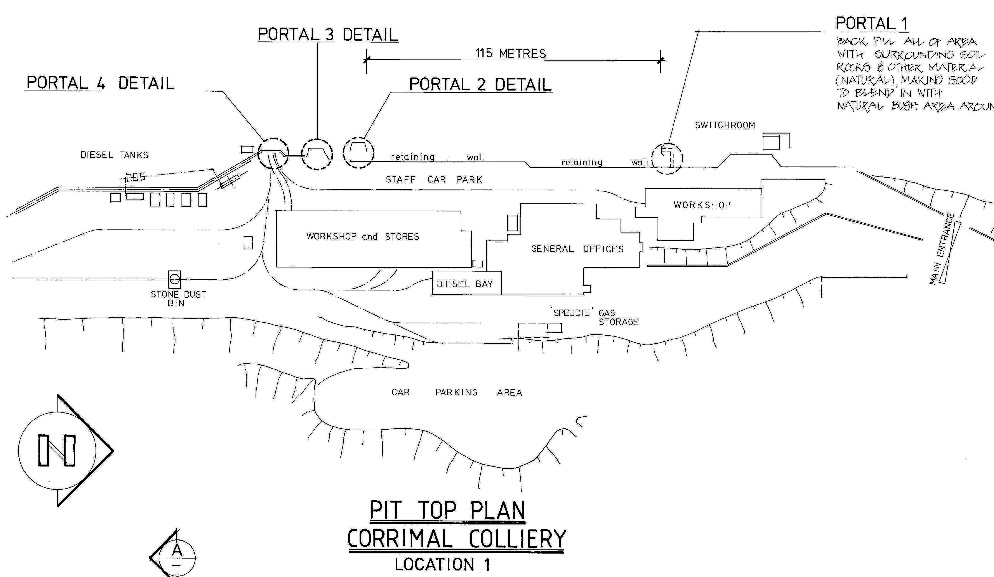
Section of the approval plan to seal the pit top entries ex Dwg. CA12072 1990
1991 – Corrimal No 1 Shaft re-capped, the wooden headframe refurbished (now under heritage listing) and the colliery portals sealed. (contractors Colrok Mining and Civil Engineers). (B.S.)
1992 – Corrimal No 3 Shaft converted to an U/cast shaft for Cordeaux Colliery by the addition an Aerex 218WZ centrifugal fan ex Kemira Colliery #2 Shaft (previously ex John Darling Colliery).
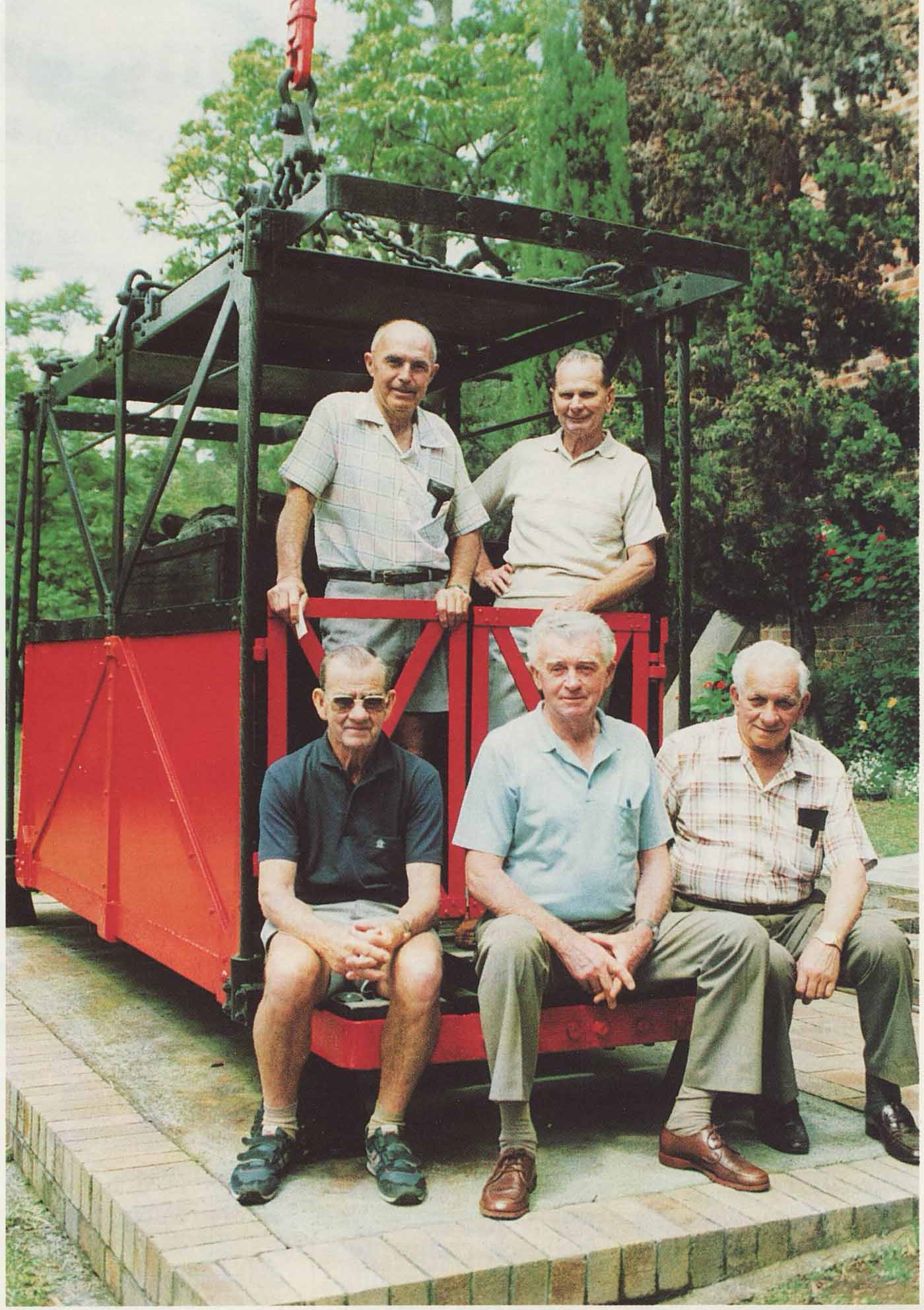
The cage from Corrimal #1 Shaft after restoration on display at the Balgownie Mining Museum c. 1993
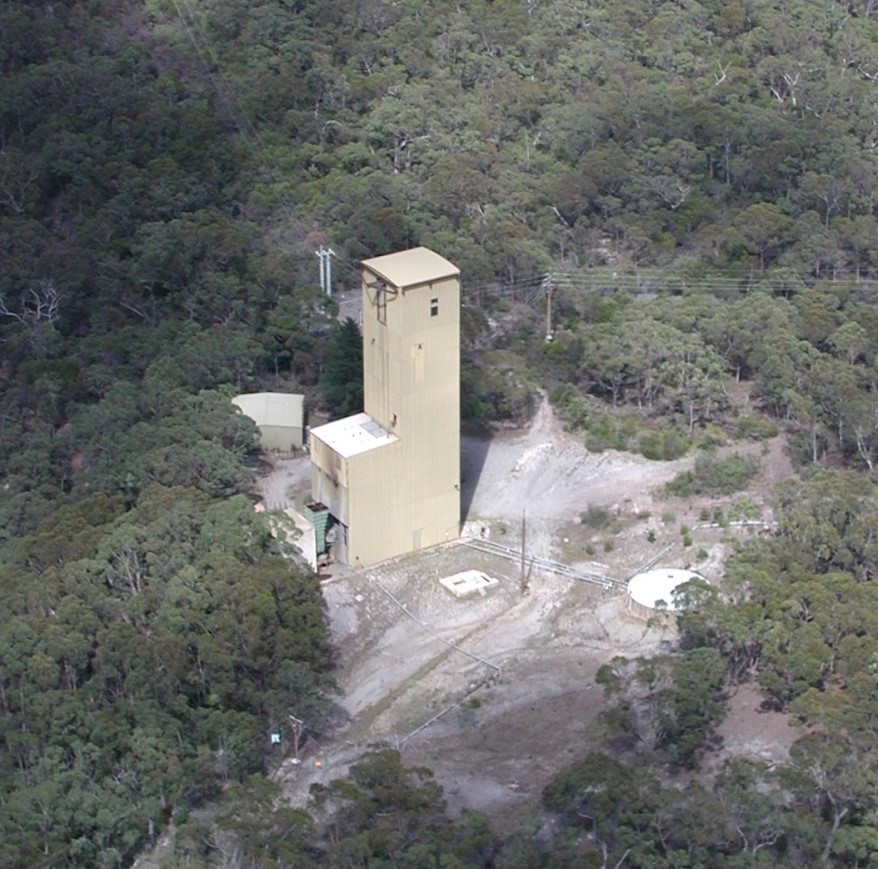
Corrimal No. 3 Shaft c. 2003 (fan utilised by Cordeaux Colliery)
1993 – 4th July, a fire at the Corrimal Colliery site destroys the main administration block, damaging it beyond repair. The building was demolished the following day. (BHP Coal News, #91 July 1993)
1995 – The old locomotive “Burra” is restored and returned to duty at the Illawarra Light Railway Museum at Albion Park. (BHP Coal News #117 Dec 1995)
1996 – Corrimal Cokeworks purchased by ICC Holdings Pty Ltd at the same time as Coalcliff Cokeworks.
2003 – Corrimal No 3 Shaft fan shut down (but shaft remains open as naturally ventilating U/C shaft) as redundant when Cordeaux Colliery reverts to care and maintenance status. (B.S.)
2005 – Corrimal No 2 Shaft is backfilled and concrete capped and the site rehabilitated. (contractors - Select Civil). (B.S.)
2008 – Illawarra Coke Company Pty Ltd still operating both the Corrimal and Coalcliff Cokeworks.
2013 – Corrimal No 3 Shaft acting as the upcast (natural ventilation) for Cordeaux Colliery. (B.S.)
2013 – Corrimal No. 2 Mine furnace shaft “rediscovered”. (B.S.)
2017 – Corrimal No 3 Shaft still acting as the upcast (natural ventilation) for Cordeaux Colliery. (B.S.)
SOURCES, REFERENCES & CREDITS
Sourced in part from “The Corrimal Colliery Railway” by K. McCarthy [Light Railways No. 60]
ISBN 0 909340 06 4 April 1978
Additional data from “Corrimal Colliery No. 2 Ventilation Shaft – Heritage and Archaeological
Assessment” B. Rogers 2003
Information sourced from “Coalfields and Collieries of Australia” by F. Danvers Power 1912
Fatalities 1965-1983 as recorded in Report Book required to be kept as per Section 36, CMRA-1912, previous fatalities as per Dept. of Mines Annual Reports
Cokeworks data sourced, in part, from the Illawarra Coke Company’s web site.
The National Library of Australia’s Trove web site was also a great source of information.
NOTES
10/09/2013 – initial inspection of Corrimal #2 Mine Furnace Shaft w/- J. Reay.
Co-ords by J. Reay: E150 52’ 51.5” S 34 22’ 12.1” converted to MGA (by BS) E305,148.7 N6,194,780.1m
Depth measured from brick collar = 6.5m to base of fully brick lined shaft (Balg. Floor. No gas detected.
GPS location (by BS) E305,148 N6,194,787m.
Shaft had been originally covered however had been accessed.
Sheldrill Field Book 5/8/08 - ?
